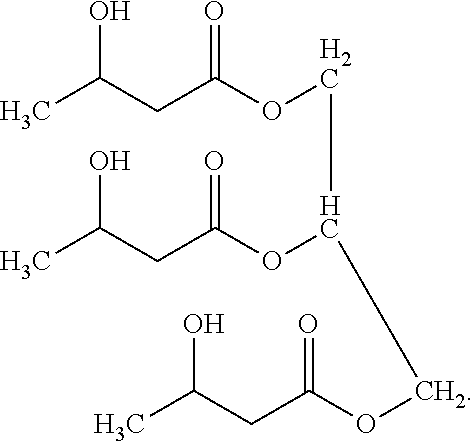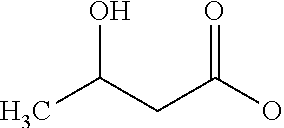Glyceryl 3-hydroxybutyrates for traumatic brain injury
- Summary
- Abstract
- Description
- Claims
- Application Information
AI Technical Summary
Benefits of technology
Problems solved by technology
Method used
Image
Examples
example 1
[0041]A 60 kg female presents with TBI due to a minor car accident. On initial examination, within 1 hour of the accident, moderate TBI is determined by EMT at the scene, on the basis disorientation and of the Glasgow Coma Scale (9-13). The patient is conscious, is hyperglycemic and able to orally ingest the ester. The patient is started on 0.5 g / kg / day glyceryl tris(3-hydroxybutyrate) orally in 3 divided doses (i.e., 10 g per serving 3 times a day). The patient is transported to a medical facility and allowed to ingest a standard diet lunch, having no glucogenic calorie restriction. After 2 days, the patient appears to have recovered from her disorientation, is released and advised to continue self-administration of the glyceryl tris(3-hydroxybutyrate) for an additional 5 days, while continuing to eat her normal meals, and to return for re-evaluation at that time. The patient completes the regimen. The patient is followed up on completion of the regimen (at day 7 on the regimen) an...
example 2
[0042]A second 60 kg female presents with TBI due to a minor car accident. On initial examination, within 1 hour of the accident, moderate TBI is determined by EMT at the scene, on the basis of disorientation and of the Glasgow Coma Scale (9-13). The patient is hyperglycemic, conscious and able to orally ingest the food and medication. The patient is started on a ketogenic diet in order to induce ketone elevation and reduce her hyperglycemia. The patient although still being somewhat disoriented, is moderately hypoglycemic and is released after 2 days to a caregiver who can observe for worsening symptoms and is directed to continue on the ketogenic diet for 5 more days and return for re-evaluation. The patient abandons the ketogenic diet almost immediately after being released. The patient is followed up on what should have been the 7th day of ketogenic diet and although not diabetic, shows improper glycemic control, appears to be have residual disorientation, and shows signs of pos...
example 3
[0043]A 70 kg male (boxer) presents with a sports injury concussion after having a history of 3 similar concussions over the past year. The past concussions are treated by standard medical practice without the use of ketogenic diet, starvation, or the esters of use in the present invention. The most recent concussive injury occurs 2 hours before the patient being brought into a hospital for treatment. The patient is immediately examined and determined to be hyperglycemic and to have a moderate concussive injury (on the basis of short term loss of consciousness, his lingering disorientation, and a Glasgow Coma Scale score of 9-13). The patient is started on 2.0 g / kg / day glyceryl tris(3-hydroxybutyrate) in three divided doses (i.e., 46.7 g per serving 3 times a day) and permitted an ordinary standard oral diet not having glucogenic caloric restrictions for a 70 kg male. Treatment continues for 3 days. On evaluation at that time, the patient appears to have recovered from his disorient...
PUM
| Property | Measurement | Unit |
|---|---|---|
| Fraction | aaaaa | aaaaa |
| Fraction | aaaaa | aaaaa |
| Time | aaaaa | aaaaa |
Abstract
Description
Claims
Application Information
 Login to View More
Login to View More - R&D
- Intellectual Property
- Life Sciences
- Materials
- Tech Scout
- Unparalleled Data Quality
- Higher Quality Content
- 60% Fewer Hallucinations
Browse by: Latest US Patents, China's latest patents, Technical Efficacy Thesaurus, Application Domain, Technology Topic, Popular Technical Reports.
© 2025 PatSnap. All rights reserved.Legal|Privacy policy|Modern Slavery Act Transparency Statement|Sitemap|About US| Contact US: help@patsnap.com



